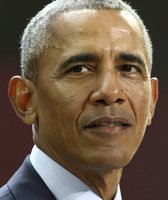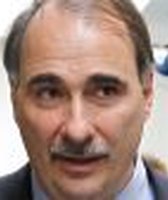Get PolitiFact in your inbox.
SUMMARY: The race is tight and the campaigns are digging deeper for the dirt.
As we enter the final month of a tight presidential campaign, things are taking a decided turn for the nasty — or at least nastier — as both the McCain and Obama campaigns have gone to the archives to attack their opponent.
From the campaign of Sen. Barack Obama comes a new Web site with a mini-documentary about McCain’s role in the Keating Five scandal.
It was launched immediately after the campaign of Sen. John McCain, led by Gov. Sarah Palin, went on the attack by claiming that Obama was too chummy with a one-time Chicago anti-war radical accused of conspiring to bomb federal buildings in the early 1970s.
PolitiFact looked into both stories and found that while the larger implications are certainly debatable, their underlying facts are mostly accurate.
Obama and Ayers
Back in the primary, Sens. Hillary Clinton and John McCain made some political hay of Obama’s relationship with William Ayers, a onetime member of the Weather Underground, a leftist fringe of the 1960s antiwar movement that was responsible for bombings at several federal buildings in the early 1970s.
PolitiFact looked at the claim back in April and found from 1999 to 2001, Obama and Ayers served overlapping terms on the board of directors for the Woods Fund, a philanthropic organization in Chicago. Campaign finance reports show Ayers donated $200 to Obama’s re-election campaign in 2001.
Since the general election began this summer, the McCain campaign had largely kept the issue on the shelf. But an Oct. 3, 2008, a story in the
New York Times
that added some new details to the association between the two provided the McCain campaign just enough kindling to revisit Obama’s long-ago association with the controversial figure.
And now, Palin is running with it.
"Well, I was reading my copy of the
New York Times
the other day, and I was really interested to read about Barack’s friends from Chicago," Palin said at a rally in Clearwater, Fla., on Oct. 6.
"Turns out, one of his earliest supporters is a man named Bill Ayers. And according to the
New York Times
, he was a domestic terrorist and part of a group that, quote, ‘launched a campaign of bombings that would target the Pentagon and the U.S. Capitol.’ Wow."
She went on to recount the story of how Ayers’ hosted a political meet-and-greet for Obama, at the request of the state senator who was leaving the seat Obama was seeking.
Ayers was, in fact, a founding member of a group known as the Weathermen, who were responsible for bombings of the New York City police headquarters in 1970, of the Capitol building in 1971 and of the Pentagon in 1972 in protest of the Vietnam War.
Ayers and his wife, Bernardine Dohrn, also a Weather Underground member, spent years as fugitives in the 1970s, but federal riot and bombing conspiracy charges were dropped in 1974 because of illegal wiretaps and other prosecutorial misconduct.
Since then, Ayers has rehabilitated his image with many in the Chicago community, including Mayor Richard M. Daly. Ayers is now a professor of education at the University of Illinois at Chicago and has developed a reputation as an advocate for school reform. Which is, according to Ben LaBolt, an Obama campaign spokesman, how the two met.
Obama and Ayers served at the same time on the board of the Chicago Annenberg project, a national school reform project. It was in one of those years, 1995, that Ayers held the Obama event at his home.
Obama campaign spokesman LaBolt told PolitiFact the two have not communicated by phone or e-mail since Obama became a U.S. senator in 2005, and that they last spoke to one another about a year ago, when they bumped into each other in the neighborhood — they live just a few blocks apart.
"The suggestion that Ayers was a political adviser to Obama or someone who shaped his political views is patently false," LaBolt said. "As the New York Times c onfirmed, the two were not close."
As for Palin’s statements themselves — the ones in Clearwater — we find they are Mostly True.
McCain and the Keating Five
Days after McCain’s campaign started attacking Obama’s past association Ayers, Obama’s campaign countered with a 13-minute Web video on McCain’s history with convicted banker Charles Keating, Jr.
The documentary burrows deep into the details of McCain’s role in the Keating Five, a quintet of senators investigated for pressuring regulators on Keating’s behalf prior to his notoriety as a villain in the late 1980s savings-and-loan crisis.
"McCain intervened on behalf of Charles Keating with federal regulators tasked with preventing banking fraud," according to the Obama Web site, "and championed legislation to delay regulation of the savings and loan industry – actions that allowed Keating to continue his fraud at an incredible cost to taxpayers."
Let’s check the evidence.
Keating and McCain, both former Navy fliers, met at a Navy League dinner in 1981, and became friends and mutual supporters.
Keating, a prominent Arizona banker, organized fundraisers for McCain’s campaigns for the House and later the Senate, and donated $112,000 to McCain by 1987. He also hosted the McCain family at least nine times at his lavish vacation home in Cat Cay, Bahamas.
"I genuinely liked him and enjoyed being around him, especially on those occasions when Cindy and I and our oldest child, Meghan, were invited to his family’s vacation home in the Bahamas," McCain wrote in his 2002 book Worth the Fighting For: A Memoir.
Keating complained frequently to McCain about regulations – and regulators – that he said threatened the success of the Lincoln Savings and Loan, a subsidiary of Keating’s American Continental Corp.
McCain was persuaded to act. On two occasions in 1987, he and fellow Sens. Dennis DeConcini of Arizona, Alan Cranston of California, John Glenn of Ohio and – in the second meeting – Don Riegle of Michigan, (McCain was the only Republican), met with federal regulators at Keating’s request and asked them to back off Lincoln.
During the second meeting, regulators told the senators they suspected Lincoln of criminal misconduct, and intended to refer the matter to the Department of Justice. That took the senators aback – McCain, in particular, did nothing more on the matter, a Senate investigation later found.
The regulators went on to recommend a criminal investigation of Lincoln, but little came of the recommendation until the government seized the failing institution in 1989.
It is clear that indeed McCain "intervened on behalf of Charles Keating with federal regulators tasked with preventing banking fraud," as the Obama campaign claimed.
In fact, McCain had intervened on Keating’s behalf before.
Having "heard frequently from Charlie" about a proposed savings-and-loan regulation called the "direct investment rule," Mcain tried to fight the regulation or get an exemption for Lincoln, he wrote in his book.
McCain wrote letters to White House officials and cosponsored a House resolution to delay the new regulation but none of it worked. "The rule was promulgated on schedule," McCain wrote, "and Lincoln’s application for an exemption was rejected."
It’s hard to see how McCain’s championing of this legislation "allowed Keating to continue his fraud," since the legislation failed.
It’s also important to note that the Senate Ethics Committee, after a 14-month investigation into the Keating Five, largely exonerated McCain, citing him only for "poor judgment."
Keating was convicted in 1993 of 73 counts of wire and bankruptcy fraud, and served 50 months before the conviction was overturned on a technicality. In 1999 he pleaded guilty to four counts of fraud and was sentenced to time served.
The government seizure of Lincoln cost taxpayers more than $2-billion.
So it’s clear that McCain did intervene for Keating, though he retreated once criminal activity was alleged. And there’s no clear evidence that McCain’s involvement "allowed Keating to continue his fraud." As a result, we find this claim Mostly True .
Our Sources
PolitiFact, Obama served on board with Ayers
New York Times, Obama and ’60s Bomber: A Look Into Crossed Paths , by Scott Shane, Oct. 3, 2008
Politico, Obama once visited '60s radicals , by Ben Smith, Feb. 22, 2008
Obama Campaign Web site, Fact Check on Obama and Ayers , April 17, 2008
Politico, Ax on Ayers , by Ben Smith, Feb. 26, 2008
New York Times, "No Regrets for a Love Of Explosives; In a Memoir of Sorts, a War Protester Talks of Life With the Weathermen," by Dinitia Smith, Sept. 11 2001
Bill Ayers’ blog, "Episodic Notoriety–Fact and Fantasy," by William Ayers, April 6, 2008
Keatingeconomics.com , accessed Oct. 6, 2008
Arizona Republic, McCain Profie: The Keating Five , March 1, 2007, accessed Oct. 6, 2008
New York Times, Times Topics: Keating Five , accessed Oct. 6, 2008
YouTube.com, John McCain in 2002 Talking About the Keating Five Scandal , August 31, 2008, accessed Oct. 6, 2008
New York Times, Senate Inquiry in Keating Case Tested McCain , Nov. 21, 1999
Roll Call, Excerpts from Committee Decisions on Four Senators, Feb. 28, 1991
Boston Globe, Amid McCain's New Status, Old Scandals Stir, Feb. 28, 2008
Worth the Fighting For: A Memoir, by John McCain, 2002
Sunday Times (London), "Terrorist link puts Obama under fire," by Sarah Baxter, April 13, 2008
New York Times, "The Oldest Rad," by Brent Staples, Sept. 30, 2001
Interview with Deborah Harrington, president of the Woods Fund of Chicago, March 3, 2008
Interview with Ben LaBolt, a spokesman for the Obama campaign, Oct. 6, 2008








































